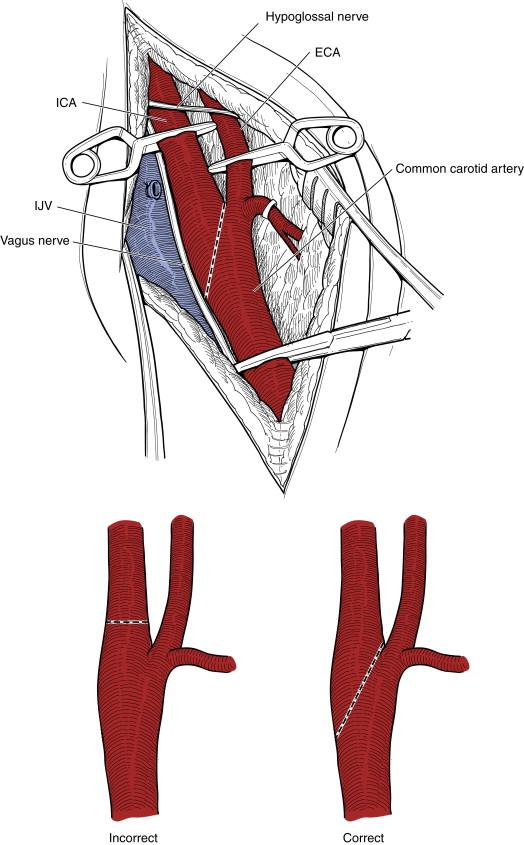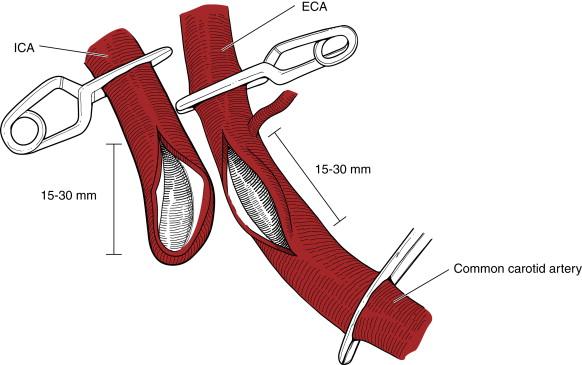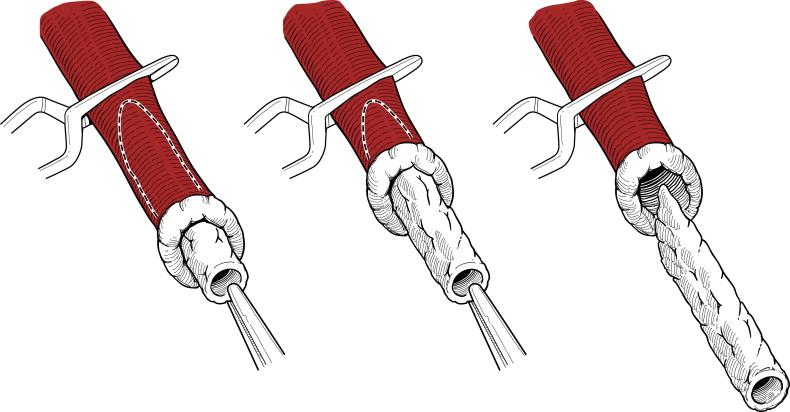Physical Address
304 North Cardinal St.
Dorchester Center, MA 02124
Conventional carotid endarterectomy (CEA) is an excellent and time-tested technique; however, eversion CEA is quicker to perform, avoids insertion of prosthetic material, and is associated with postoperative morbidity and restenosis rates that are comparable with those for conventional CEA. Because it is faster to perform, it is ideal for carotid surgery under regional anesthesia.
Eversion CEA was first performed by Kieny and associates in 1985, improving upon the technique described by DeBakey from 1959 and Etheredge in 1970. The DeBakey-Etheredge technique involved transecting the common carotid artery and the everting internal carotid artery (ICA) and external carotid artery (ECA) as one. The Kieny technique confines eversion to the ICA.
Until recently, eversion CEA has been slow to gain widespread acceptance. Many surgeons found it a difficult technique to master, some had concerns about adequate visualization of the distal endpoint, and many were worried about inserting a shunt expeditiously when needed. This chapter reviews the technique of eversion CEA, paying special attention to commonly perceived problems and related strategies that may need to be applied to achieve an optimal outcome.
CEA is indicated to prevent stoke in patients with carotid bifurcation occlusive disease. Multiple randomized prospective studies support CEA for (1) asymptomatic patients with a carotid stenosis of at least 60% and (2) symptomatic patients with a history of recent transient ischemic attack (TIA) or amaurosis fugax and an ipsilateral carotid stenosis of at least 50%.
Additional indications for CEA have been reported. Given the limited available evidence, the decision to recommend treatment should be based upon the surgeon’s complication rate and the patient’s preference. Specifically, the benefits of CEA are less established for (1) patients with a carotid stenosis of at least 50% and nonhemispheric symptoms, vertebrobasilar symptoms, stroke in evolution, or a completed acute stroke and (2) symptomatic patients with an ulcerated carotid plaque and an ipsilateral carotid stenosis of less than 50%.
All patients should have a preoperative duplex ultrasound. Computed tomography (CT) angiography may be considered to confirm the presence of a significant stenosis. Magnetic resonance angiography has few advantages over CT angiography yet has a potentially higher false-positive rate for the detection of a hemodynamically significant carotid lesion. Conventional contrast angiography is rarely needed.
Patients should have preoperative cardiac clearance.
Patients who are on aspirin and clopidogrel should have both medications continued through the perioperative period. All patients should be on at least one antiplatelet agent.
Nearly all patients may undergo eversion CEA under a regional block consisting of a combined deep and superficial cervical plexus block or a superficial cervical plexus block only. Sedation in the form of remifentanil (Ultiva), a very short-acting narcotic, is used to allow strict control of the patient’s sedation score. General anesthesia is required in fewer than 1% of their patients.
Cerebral function is assessed clinically by noting changes in the patient’s ability to converse or recall simple facts. A more objective measure is to ask the patient to squeeze a pressure bag attached to a pressure transducer when the ICA is clamped.
Perioperative systolic blood pressure is maintained between 120 and 170 mm Hg, especially during carotid clamping, to allow adequate cerebral perfusion. Beta-blockers, such as labetalol (Trandate) administered intravenously in 5-mg increments, is used as a first-line agent, and hydralazine, administered intravenously in 10-mg aliquots, is often a second-line agent.
Surgeons adopting eversion CEA need not alter their basic technique for exposure of the carotid arteries ( ![]() ). The anesthetic, as well as the methods of cerebral monitoring and protection, are similar for both eversion and standard CEA. Eversion CEA under cervical block anesthesia is preferred, with selective shunting for patients who develop neurologic changes during carotid artery clamping.
). The anesthetic, as well as the methods of cerebral monitoring and protection, are similar for both eversion and standard CEA. Eversion CEA under cervical block anesthesia is preferred, with selective shunting for patients who develop neurologic changes during carotid artery clamping.
Eversion CEA can be used to treat almost all cases of primary carotid bifurcation disease and select cases of recurrent stenosis. It is ideal for treatment of carotid arteries with kinks or loops, because shortening of the artery can be incorporated within the process of eversion. The use of shunts is straightforward and safe, and in some cases, a shunt can facilitate the procedure. Once inserted, the shunt can be used as a mandrel to evert the ICA and adequately remove the atherosclerotic plaque. The extent of disease at the carotid bifurcation may affect the ease of performing CEA by any method. Disease limited to or near the bifurcation is easier to treat than disease that extends distally. Inspection of the ICA guides the surgeon on the extent of the plaque before division of the ICA. Treatment of extensive disease in the ICA up to or beyond the level of the anterior digastric muscle can be challenging. Such cases should be treated by conventional CEA until ample experience with eversion CEA is gained on arteries with focal bifurcation disease.
Although the eversion technique can be used for treatment of recurrent carotid stenosis after an initial eversion procedure, it is contraindicated in patients who underwent conventional CEA with prosthetic patch angioplasty. A carotid artery patched with autogenous vein may be suitable for treatment using the eversion technique, but failure rates are higher than recurrent disease in vessels without a patch angioplasty. Radiation-induced carotid artery stenosis may also impose limitations on the eversion technique because of the difficulty in defining an endpoint and may be better served by patch angioplasty.
Exposure of the carotid artery for eversion CEA is similar to that for conventional CEA. However, several points deserve emphasis. In the eversion technique, moreso than in conventional CEA, it is essential to mobilize the distal ICA circumferentially, well beyond the plaque, to the level where the uninvolved artery achieves a bluish hue. The clamp should be placed on the normal ICA beyond the endpoint or transition zone of the plaque to facilitate eversion and allow examination of the endpoint of the endarterectomy. It is also important to clear all periadventitial tissue away from the ICA to allow adequate eversion of the ICA. This can be performed after transection of the ICA and allows much of the dissection to be done with the ICA “out of the wound,” thus minimizing the risk of cranial nerve injury.
After administration of heparin (30 units/kg, average 2500 units per patient), the ICA is clamped using Yasargil neurosurgical clips. Then the ECA and common carotid artery are dissected and clamped. The ICA is then transected obliquely at its origin using an 11 blade and dissecting scissors and is freed from remaining periadventitial tissue. The ICA should be divided at the bifurcation or carotid bulb, not in the proximal ICA ( Fig. 7-1 ). If the proximal ICA is divided, it makes the subsequent anastomosis more technically challenging. The arteriotomy is extended along the medial side of the ICA for 1 to 2 cm ( Fig. 7-2 ). The arteriotomy in the common carotid artery is extended for a similar distance. At this stage, the ICA should be fully mobilized and anchored only by the distal ICA Yasargil clip.


Eversion CEA of the ICA is then performed. A dissection plane is first identified on the proximal ICA. The adventitia is then peeled off the plaque ( Fig. 7-3 ). As the eversion proceeds, fragments of plaque that remain on the arterial side of the adventitia are removed. The plaque is not extracted from the artery; rather the adventitia is peeled off the stationary plaque, much like peeling a glove from a hand. As the adventitia is peeled off, the plaque begins to “feather out” where it ends before separating from the adventitia. A small rim of residual plaque may be seen after removal of the bulk of the plaque, which is removed as a spiral to minimize the risk of dissection plane of the distal normal intima. Irrigation with heparinized saline removes residual debris and provides a clearer view of residual strands on the intimal surface of the ICA. A critical part of this operation is good visualization of the distal endpoint of the endarterectomy. If not clearly visible, the Yasargil clamp should be moved more cephalad on the ICA.

Two technical problems are possibly encountered at this stage:
Lack of a distal end point. When the ICA is inverted, the plaque may not “feather out” but instead may become continuous with the distal intima. This is analogous to endarterectomy of the superficial femoral or iliac arteries. The surgeon must stop the endarterectomy before the ICA is out of reach at the skull base. The ICA with its plaque may be transected, and often the distal endpoint is secure. If this does not occur, the plaque may be tacked with 7-0 or 8-0 polypropylene sutures or a common carotid artery to ICA bypass may be performed.
Unstable distal endpoint. After successful endarterectomy, there may be concern that the intima is separating from the distal ICA, which could dissect after reestablishing flow. Tacking (Kunlin) sutures, made with 7-0 or 8-0 polypropylene, may be used to secure the distal intima.
Become a Clinical Tree membership for Full access and enjoy Unlimited articles
If you are a member. Log in here